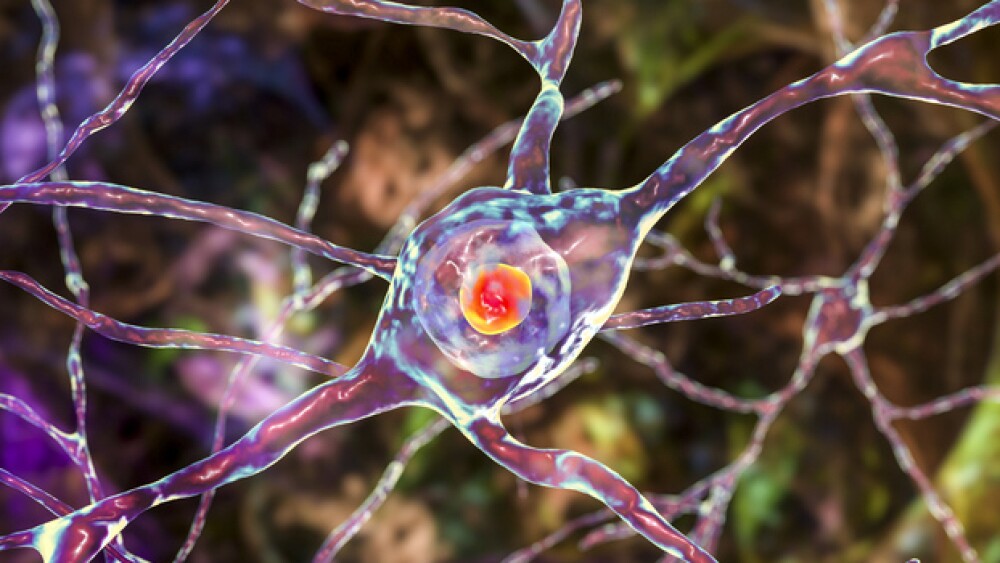For forms of Alzheimer’s, frontotemporal dementia and Parkinson’s caused by genetic defects, gene therapy could change the treatment landscape.
Pictured: Neuronal intranuclear inclusions/iStock, Dr_Microbe
Millions of people living with neurodegenerative diseases and their loved ones have long hoped for the day when treatments could change the prognosis from an inevitable decline to a managed, stable condition. The urgent need for life-changing therapies exists against the backdrop of a growing prevalence of Alzheimer’s disease, Parkinson’s disease and other progressive disorders.
Neurodegenerative diseases are historically difficult to treat and effective therapies have eluded even the most dedicated scientific minds for decades. However, scientific innovation in neurology and a growing understanding of underlying disease pathology is opening the door to novel pathways to treat, and potentially cure, myriad diseases.
Gene Therapy: Targeting the Cause
More and more, scientists are identifying and developing ways to treat the fundamental cause of certain neurodegenerative diseases rather than merely treating the symptoms. Take, for example, a disease like frontotemporal dementia (FTD), which, in some cases is caused by a single genetic defect. In up to 10% of people with FTD—a disorder that affects the frontal and temporal lobes of the brain and is one of the most common causes of early-onset dementia—the disease is caused by a mutation in the granulin gene. The defective gene creates a deficiency of progranulin, a complex and highly conserved protein thought to play several critical roles in lysosomal function.
With the potential to correct the defect at its source by delivering a functional copy of the gene that is mutated, nonfunctional or missing, gene therapy could be a powerful treatment approach.
As in many genetic disorders, delivery is a critical aspect of developing gene therapies for neurodegenerative diseases. Precise approaches that deliver one-time treatments directly to the brain and address the root cause of the disease have shown promise.
The blood-brain barrier and potential off-target effects have made traditional drug development especially difficult for neurodegenerative diseases. But a gene therapy delivered directly to the cerebrospinal fluid (CSF) surrounding the brain and spinal cord has the potential to overcome these limitations and achieve long-term correction of these illnesses.
In the case of FTD, once delivered, a new gene may confer stable, long-term expression of the required protein, offering effective, long-term disease-modifying treatment. There is also the potential benefit of cross-correction, where the protein is secreted into the interstitial fluid and CSF, possibly expanding the benefits to cells beyond those directly transduced. If this secreted protein can confer general neuroprotective effects, gene therapy could be a transformative treatment option for a range of neurodegenerative diseases—even those not caused by a specific genetic defect.
Accessing the Brain With AAV Delivery
In order to reach a broad range of tissues, including hard-to-target organs like the brain, many gene therapy developers are taking advantage of the leading viral vector platform: adeno-associated viruses (AAVs). Wildtype AAVs, which are not known to cause human disease, are one of the most promising in vivo tools for delivering a functional copy of a gene to cells in both the central nervous system and periphery.
The strength and versatility of AAV-based vector technology has contributed significantly to the FDA approval of several gene therapies. Today, eight such therapies are on the market for a range of indications. Notably, Novartis broke new ground in the treatment of spinal muscular atrophy, a rare neuromuscular disorder, with the 2019 approval of Zolgensma. This one-time gene therapy targets the genetic root cause of SMA by replacing the function of the missing or nonworking SMN1 gene, halting progression of the disease.
A gene therapy program being developed by my company, Passage Bio, is focused on the treatment of FTD with granulin mutations, for which there are currently no approved disease-modifying therapies.
Passage’s global Phase I/II clinical trial is evaluating PBFT02, an AAV-delivery gene therapy candidate that uses a differentiated approach to directly target the CNS via intra-cisterna magna (ICM) administration. In ICM administration, therapy is delivered directly to the CSF via injection into the cisterna magna, an area outside of the brain near the base of the skull.
The Pursuit of Transformative Medicines
The work underway at Passage is a mere snapshot of the many positive advancements happening across the field. Genetic medicines continue to demonstrate their ability to dramatically improve lives. There are currently hundreds of promising gene therapy programs in various stages of development, many of which are producing encouraging clinical data.
The progress is palpable, but challenges remain. The pursuit of science is filled with twists and turns. Just like the development of a small molecule, a gene therapy program is only as promising as its clinical data—and every program is truly unique. That’s why Passage and other companies seeking solutions for individuals with neurodegenerative diseases must have a razor-sharp focus on clinical execution to generate impactful results that will improve the lives of these patients and their families.
William Chou, MD, CEO of Passage Bio, is an accomplished executive with nearly twenty years of healthcare experience across a range of development and commercialization roles. Chou holds an MBA from the Yale School of Management, an MD from the University of Pittsburgh School of Medicine, and an AB in politics and economics from Princeton University. He completed his residency in internal medicine at Yale New Haven Hospital and his fellowship in geriatrics at Yale University.





